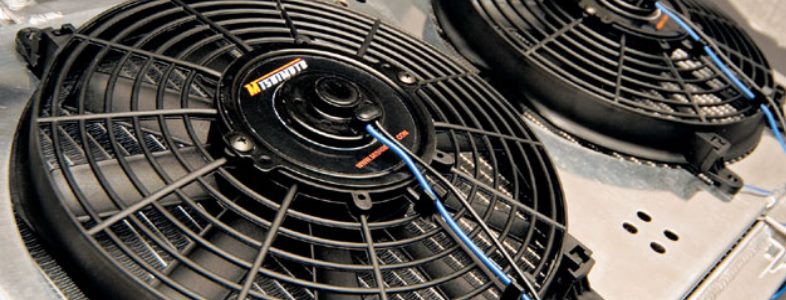
Stock vs. Performance
A stock radiator may be fine for your grandmother who drives 25 mph to the grocery store once a week, but for those of us who can never have enough power a high-performance cooling system is a must!
Even if you don’t put a beating on your car everyday, we all have that urge to push our cars to their maximum ability. A blown motor is the last thing anyone wants to deal with. After all, you deserve to be able to push your car to the limits! High-quality, reliable cooling products are essential if you want to enhance the lifetime and performance of your vehicle, while at the same time preventing engine failure.
The Engine
A car’s engine has tons of moving components. As these parts move they create friction, which creates heat. Motor oil is pumped through the engine block to assist in lubricating these moving parts; however, motor oil is not enough to beat the heat! As a normal result of a working engine, the parts become boiling hot.
If you have that need for speed and are running an upgraded or modified engine, you will need to upgrade your cooling system as well. Stock radiators can’t handle the heat produced by these types of engines. The more horsepower your engine puts out, the more heat it produces. The engine block must be kept cool to avoid overheating and/or seizures. If the pistons cannot slide freely in their cylinders due to the excessive heat caused by friction, they will eventually snap and cause total engine failure.
The Radiator
The radiator plays the most important role in maintaining a cool, efficiently running engine while preventing overheating. A mixture of water and antifreeze is pumped through the chambers in the engine block, and when this extremely hot engine coolant exits the engine block it goes straight to the radiator through the hose kit. As the hot coolant makes its way through all the chambers, fins, and tubes of the racing radiator, the extremely hot engine fluid is now cool enough to return to the engine block. This is a continuous process and the most effective way to keep your engine cool and running at its best. Aluminum radiators are the strongest and most durable. They can withstand the extreme conditions of everyday driving and are also much lighter than stock OEM radiators.
The Hose Kit
The hoses that connect from the engine block to the radiator usually come as a kit. The number of hoses in the kit depends on the make and model of your vehicle. As hoses increase in size, more fluid can flow to the radiator, thus making the cooling process more efficient Silicone Hose Kits are the most durable, especially when made with a dual-layer combining heat-resistant fibers. This allows greater pressure tolerance and the ability to withstand the extreme temperature of the hot fluid continuously flowing back and forth from the engine block to the radiator.
The Electric Fan
An electric fan helps force cooler outside air through the radiator to accelerate the cooling process. As the car moves the front of the radiator is cooled by the outside air coming through the grill. An electric fan aids in airflow to the radiator for times when there isn’t enough air getting through. When your vehicle is not moving, it is more likely to overheat. For example, every time you stop at a traffic light your vehicle is at risk of overheating due to lack of air to the radiator. The slim fans solve this problem by constantly driving cool air directly to the radiator even when you are at a standstill.
The Fan Shroud
A fan shroud is an important aspect and plays a major role in facilitating the cooling process and maintaining ideal engine temperatures. A fan shroud mounts flush against the radiator core delivering more air to the radiator and drive out the excess heat. The fan shroud also secures the fan blades in place, making your ride smoother, and protecting other vital engine components from potential damage caused by loose fan blades.
The Radiator Cap
The radiator cap is more than just a lid for your radiator. Its main job is to seal the radiator when it’s operating, while pressurizing the coolant inside. If the coolant is not kept under pressure, it would boil and eventually the coolant would evaporate. The radiator filler neck has an overflow tube. If the pressure in the cooling system exceeds the preset rating of the cap, the pressure-relief valve causes the lower seal to lift, allowing the excess pressure to escape through the overflow to the ground of the coolant reservoir. The better the radiator cap, the more hot pressurized coolant it will be able to withstand and resist.
The Thermostat
The thermostat is a temperature-controlled valve that opens at a specific regulated temperature. During engine startup most engines incorporate a bypass to quickly circulate coolant just through the block. As this coolant is heated to the operational temperature of the thermostat, the valve opens to allow coolant to circulate through the radiator. The thermostat cycles hundreds of times a day during normal driving. More heat is produced in an upgraded engine, which requires an upgraded thermostat that will open up at lower temperatures and allow the coolant to flow faster and sooner than the stock thermostat would.
The Intercooler
An intercooler is basically a heat exchanger similar to a radiator. When air is compressed its temperature significantly rises. The intercooler’s main purpose is to cool the compressed air produced by a turbocharged or supercharged engine. An air-to-air intercooler uses outside air to transfer heat. As the cool air passes from the outside through the intercooler tubes and the cooling fins, the hot compressed air is then transferred outside. The location of the intercooler is important when determining how efficiently the heat will transfer. Front-mount intercoolers are very effective at heat transference because there is no interference.
The Transmission Cooler
The transmission cooler is used in vehicles with automatic transmissions. It’s like a radiator within a radiator, but instead of exchanging heat with the air, the transmission fluid passes through and is cooled by airflow.
Be sure to check out all of our Mishimoto Cooling Products here:


